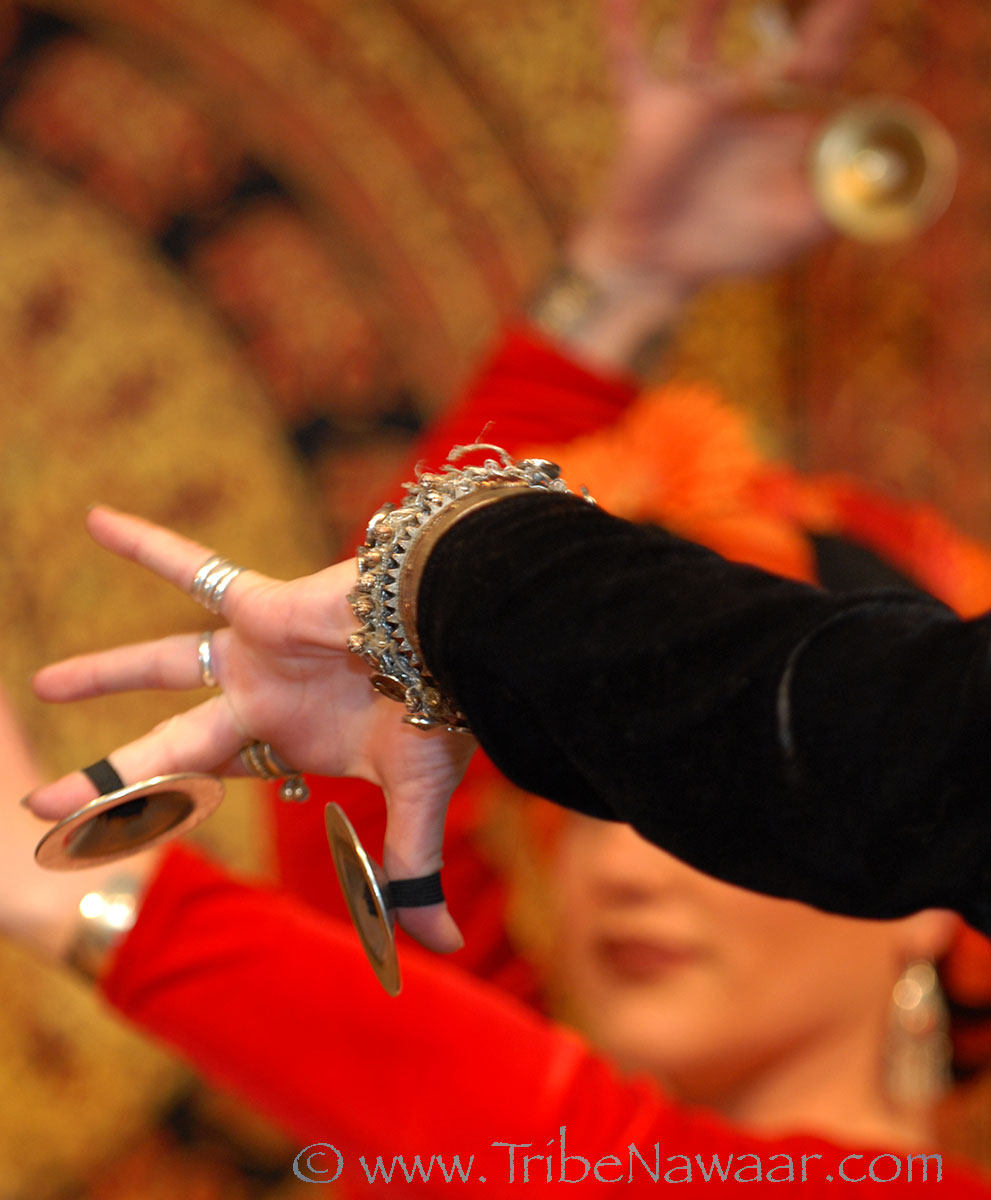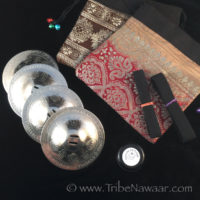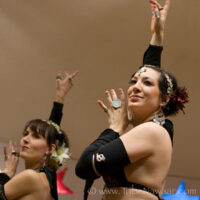Here are the basics I think every dancer should know about how to start playing zils with belly dance. I hope you find it helpful! -Jennifer
What Are Zils?
 Zils, also known as finger cymbals, sagat or by their alternate spelling with two ‘L’s, zills, are small round instruments that are much loved by belly dancers. They are made in a variety of sizes and styles. The most popular metal is brass, due to quality of sound it produces. You’ll notice this is true of the zil’s larger relative, the cymbals used in drum kits and in orchestras. That is also why many bells are made of brass! Now days you can find zils made of a variety of metal alloys, each with it’s own unique sound quality.
Zils, also known as finger cymbals, sagat or by their alternate spelling with two ‘L’s, zills, are small round instruments that are much loved by belly dancers. They are made in a variety of sizes and styles. The most popular metal is brass, due to quality of sound it produces. You’ll notice this is true of the zil’s larger relative, the cymbals used in drum kits and in orchestras. That is also why many bells are made of brass! Now days you can find zils made of a variety of metal alloys, each with it’s own unique sound quality.
High quality zils will have a consistent tone from one zil to the next within a set. The more decorative styles may have a sound that varies from one zil to the next. We typically will have a range of zils to meet a variety of preferences for sound and budget. If you need advice on choosing a set, just send us a message.
How To Wear Zils
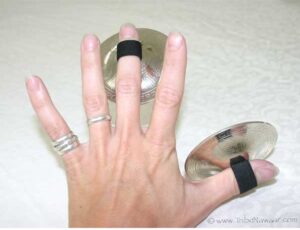 All of our finger cymbals come in sets of four, two for each hand. You will wear one zil on the thumb and one one the middle finger of both hands. Use elastic to securely hold the zils in place. The elastic should be fed thru the holes on the top (convex part) of the zils and fastened inside the concave portion of the zils. Wear your zils just over the first knuckle (the one closest to your fingernail) on both the middle fingers and the thumbs.
All of our finger cymbals come in sets of four, two for each hand. You will wear one zil on the thumb and one one the middle finger of both hands. Use elastic to securely hold the zils in place. The elastic should be fed thru the holes on the top (convex part) of the zils and fastened inside the concave portion of the zils. Wear your zils just over the first knuckle (the one closest to your fingernail) on both the middle fingers and the thumbs.
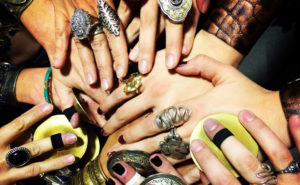 Adjust the elastic to create a snug fit. You want the elastic tight enough to keep the zil from sliding from side to side, but, not so tight that it is affecting circulation. You will have better control of your zils and thus build your confindence in playing more quickly by spending a little extra time to get the fit just right. I recommend using safety pins to hold the elastic together initially. Once you have had a chance to wear them for a while and have adjusted the fit to be as you like it, carefully, mark where your safety pins have been, remove them, then stitch the elastic together. Cut any excess elastic off, but, not too close to the stitching. Safety pins and excess elastic that are left on will dampen the zil’s tone.
Adjust the elastic to create a snug fit. You want the elastic tight enough to keep the zil from sliding from side to side, but, not so tight that it is affecting circulation. You will have better control of your zils and thus build your confindence in playing more quickly by spending a little extra time to get the fit just right. I recommend using safety pins to hold the elastic together initially. Once you have had a chance to wear them for a while and have adjusted the fit to be as you like it, carefully, mark where your safety pins have been, remove them, then stitch the elastic together. Cut any excess elastic off, but, not too close to the stitching. Safety pins and excess elastic that are left on will dampen the zil’s tone.
Pro Tip:
Try one of the ideas below to quickly be able to identify which zils fit your thumbs and which fit your fingers:
- When sewing your elastic use different colored thread for thumbs and fingers.
- Add a sequin or jewel to the top of your elastic to differentiate the finger and thumb zils.
- Use black elastic for fingers and grey or natural for thumbs.
Common Zil Sounds
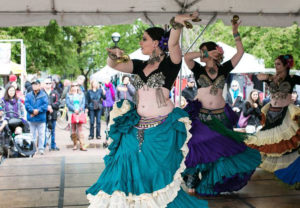 There are 3 basic sounds we make when we are playing zils: the ring, a clap and a muted tap. All are achieved by bringing the zils on the finger and thumb of the same hand together and apart in various methods.
There are 3 basic sounds we make when we are playing zils: the ring, a clap and a muted tap. All are achieved by bringing the zils on the finger and thumb of the same hand together and apart in various methods.
- The ring is the most often used sound. Bring the zils together, then quickly apart, just clipping the edges of each zil. The lovely sound of zils are best heard this way. Watch that your other fingers don’t rest on the edges of the zils and dampen the sound.
- The second sound is the clap. Flatly strike the zils together. to create this sound. We like to use this for accenting certain parts of a step.
- The muted tap is a great option when you want a more subtle and quiet sound. To achieve the muted tap, allow fingers and thumbs to curve around the zil. Stike the zils at the top edge, near the tips of the fingers and thumb. This will intentionally dampen the tone.
Basic Belly Dance Zil Rhythm
The Gallop or Longa is the most often played rhythm by belly dancers. Because the first sound is made by the right hand, the second by the left, and the third by the right, it is sometimes referred to as RLR (right, left, right).
Gallop Rhythms At Different Tempos:
- Quarter time tempo- Simply count out every downbeat 1, 2, 3, 4.
How you will play it: on beat 1 pause, on beat 2 strike Right zils, on beat 3 strike Left zils, on beat 4 strike Right zils. - Half time tempo- Count out the beats and the spaces between each beat (the upbeat); ‘and’ 1 ‘and’ 2 ‘and’ 3 ‘and’ 4
How you will play it: on ‘and’ pause, on beat 1 strike Right zils, on ‘and’ strike Left zils, on beat 2 strike Right zils on ‘and’ pause, on beat 3 strike Right zils, on ‘and’ strike Left zils, on beat 4 strike Right zils. - Full time tempo: the standard speed most zils will be played at. You will now divide the beats into quarters. This is often spoken as “and a 1 e, and a 2 e, and a 3 e, and a 4 e”.
How you will play it: on every ‘and’ you will strike Right zils, on every ‘a’ you will strike Left zils, on every downbeat (1, 2, 3, 4) you will strike Right zils. Every ‘e’ is the pause.
Can’t Dance & Play Zils Yet? Just Wear Them!
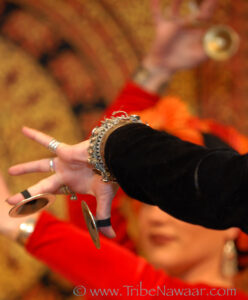 Even if you are not ready to dance and play zils at the same time I suggest wearing your zils during practice. Whether this is in class or during your at home practice you should wear them all the time. This helps you get used to the feeling of having them on your hands. Not only will your hands start to adjust to the weight and shape of the zils, you will also find it will help inform many of your movements and hand gestures.
Even if you are not ready to dance and play zils at the same time I suggest wearing your zils during practice. Whether this is in class or during your at home practice you should wear them all the time. This helps you get used to the feeling of having them on your hands. Not only will your hands start to adjust to the weight and shape of the zils, you will also find it will help inform many of your movements and hand gestures.
When you are ready to try adding the zils into your dance it will be so much easier if you are used to wearing them consistently. Even if you drop in and out of playing with the steps at first, you will be building the skills to play with comfort and confidence bit by bit.
Ok, true story here: I once had a potential student reach out about joining class. She really wanted to dance with us but hated playing zils and asked if it would be required. I told her I only require she wear them, not play them. After a short amount of time of just wearing them along with a few class zil demos she easily was able to pick them up and found they were actually FUN to play!
Tips For Practicing Finger Cymbals At Home
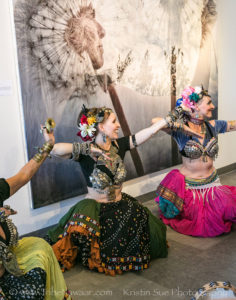 Practicing your zils outside of class is an excellent way to speed up the learning process. If you are new to playing zils you may find it easiest to start your at home practice while sitting. Once you feel comfortable with that, begin walking in time with your zil playing. Keep your hands relaxed and in front of your body, at any height is ok initially. Listen to the rhythm and tone. Play with the different sounds that can be made with your zils.
Practicing your zils outside of class is an excellent way to speed up the learning process. If you are new to playing zils you may find it easiest to start your at home practice while sitting. Once you feel comfortable with that, begin walking in time with your zil playing. Keep your hands relaxed and in front of your body, at any height is ok initially. Listen to the rhythm and tone. Play with the different sounds that can be made with your zils.
After you are comfortable start adding in some of your dance steps. If you decide to practice with music be sure to choose simple music that is in 4/4. This will fit the Gallop rhythm best. There are quite a few songs that are in 4/4. I am happy to make suggestions based on your taste in music.
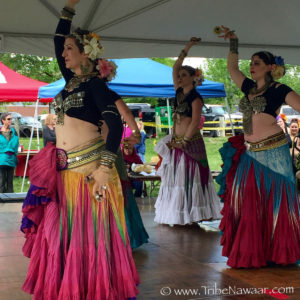 One piece that offers various tempos (and challenges!) in 4/4 is ‘Baladi Unplugged’ by Helm-FatChanceBellyDance. The song is broken up into 5 sections, of about a minute long each. Every new section begins with a demo of the Gallop pattern played at full time. The first section of music is played at a relatively moderate tempo. Each subsequent section increases the tempo until it reaches the final ‘’rocket speed’ tempo at the end. Although, the zil demo at the beginning of each section is played in full time, you can practice playing at half or quarter time.
One piece that offers various tempos (and challenges!) in 4/4 is ‘Baladi Unplugged’ by Helm-FatChanceBellyDance. The song is broken up into 5 sections, of about a minute long each. Every new section begins with a demo of the Gallop pattern played at full time. The first section of music is played at a relatively moderate tempo. Each subsequent section increases the tempo until it reaches the final ‘’rocket speed’ tempo at the end. Although, the zil demo at the beginning of each section is played in full time, you can practice playing at half or quarter time.
Get Help Playing Zils
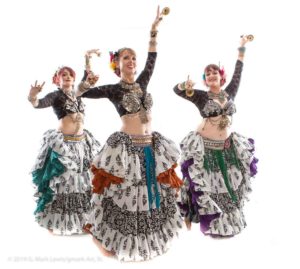 If you would like to add zils to your or your dance company’s repertoire but need some help getting started I offer both individual private lessons or group private lessons. These private lessons can be held online or at our studio in Boulder. Each lesson can be customized to fit your specific needs.
If you would like to add zils to your or your dance company’s repertoire but need some help getting started I offer both individual private lessons or group private lessons. These private lessons can be held online or at our studio in Boulder. Each lesson can be customized to fit your specific needs.
In Closing
Remember zils are a bona fide instrument, and as such take time and practice to master.. especially while trying to improvise a dance at the same time! Just try to have fun and keep practicing!
Happy zilling!
Jennifer

